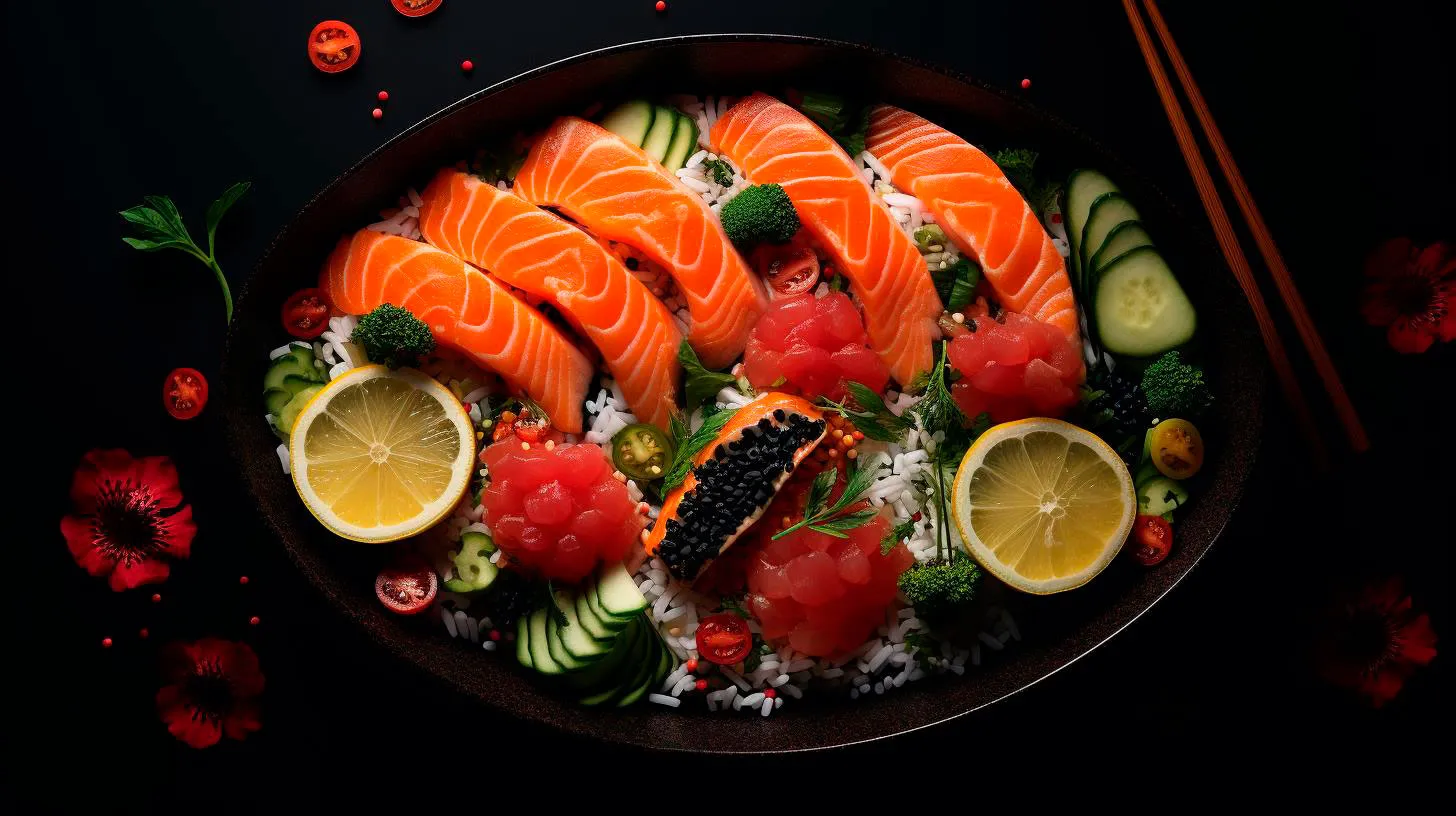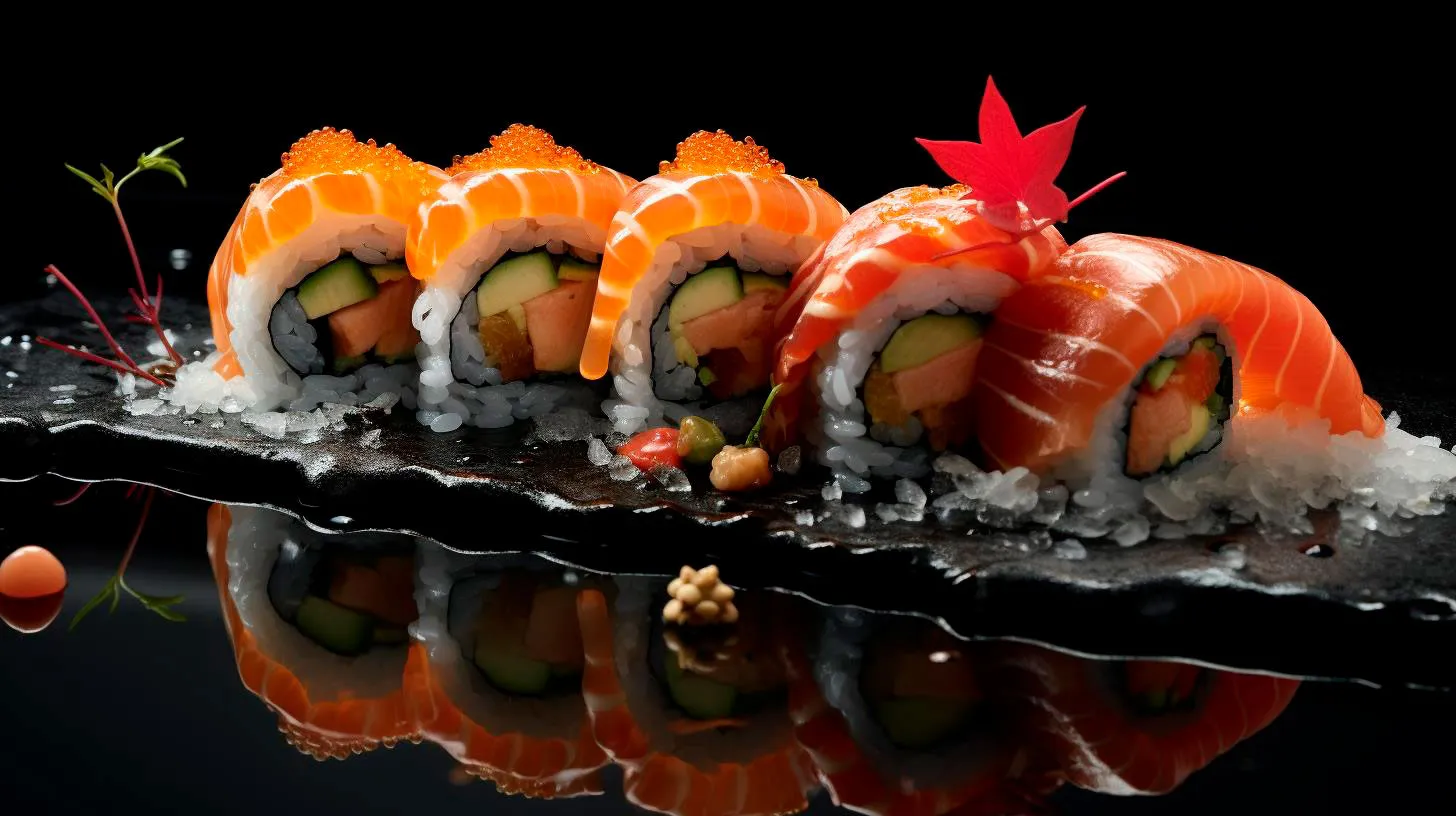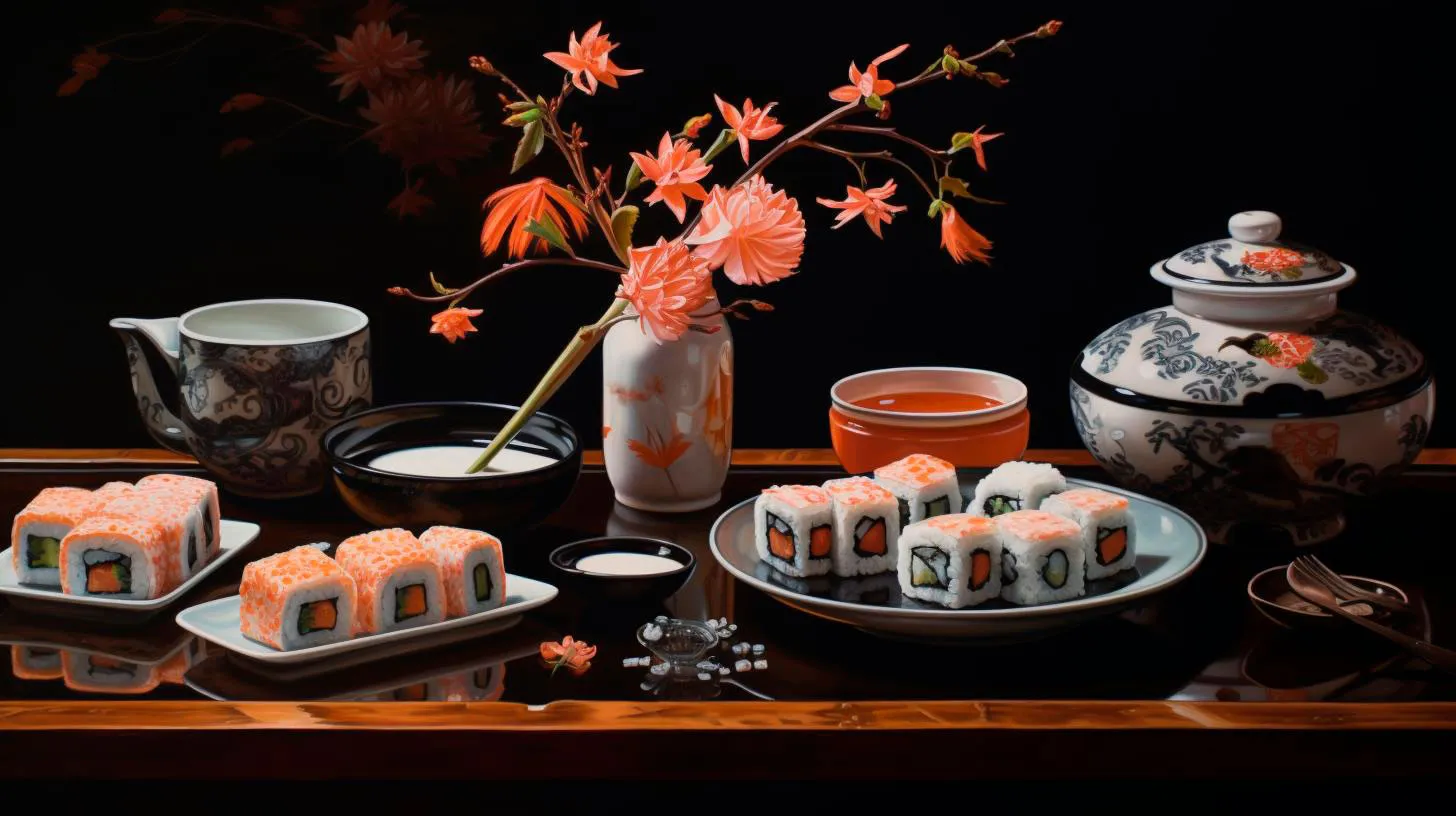Unraveling the Art of Sushi Making: Japanese vs American Techniques
Japanese Sushi-Making Techniques
When it comes to sushi-making, Japan is the birthplace of this intricate art, with a rich cultural heritage. Japanese sushi chefs undergo years of rigorous training to perfect their skills, creating masterpieces with precision and perfection. Here are some essential Japanese sushi-making techniques:
- Nigiri: The most traditional form of sushi, it consists of a small mound of vinegared rice topped with fresh fish or seafood. Japanese chefs meticulously shape the rice into bite-sized pieces and delicately place a slice of fish on top, often fusing them together using a touch of wasabi.
- Maki: Maki rolls are created by wrapping nori (seaweed) around vinegared rice and an assortment of fillings, such as fish, vegetables, or pickled roots. The rolled sushi is then tightly wrapped using a bamboo mat and cut into bite-sized pieces. Japanese chefs pay close attention to the texture, flavors, and balance of ingredients.
- Temaki: Also known as hand rolls, temaki is a cone-shaped sushi that is hand-rolled using a sheet of nori. A variety of ingredients are placed inside the nori, including fish, rice, and vegetables, creating a unique sushi experience when eaten with hands. The fresh, crisp nori and fillings are combined for a delightful taste and texture.
Japanese sushi-making techniques prioritize simplicity and focus on preserving the taste and texture of the ingredients. The sushi is typically smaller in size, allowing each piece to be savored and appreciated individually. The delicate balance of flavors and the highest quality ingredients ensure an authentic sushi experience.
American Sushi-Making Techniques
In recent years, American sushi has evolved into a modern fusion of flavors, incorporating local ingredients and innovative techniques. This has led to the emergence of unique American sushi-making techniques that cater to diverse palates. Here are some notable American sushi-making techniques:
- Inside-out Roll: Unlike traditional Japanese rolls, American sushi introduced the inside-out roll, where the rice is placed on the outside of the nori. This technique allows for creative presentations and additional ingredients, such as sesame seeds or fish roe, to be added directly to the rice.
- Specialty Rolls: American sushi has embraced the concept of elaborate specialty rolls that combine various ingredients and flavors. These rolls often feature unconventional combinations, such as cream cheese, avocado, spicy mayo, or tempura-battered fillings. The focus is on creating unique and visually appealing creations.
- Sauces and Dressings: American sushi chefs often use an array of sauces and dressings to enhance the flavor profiles of their sushi rolls. From spicy sriracha mayo to tangy eel sauce, these additions add a burst of flavor and depth to each bite, amplifying the overall sensory experience.
American sushi-making techniques offer a fusion of flavors and culinary creativity that aim to cater to a wide range of taste preferences. The larger roll sizes allow for a more filling and substantial sushi experience, often accompanied by vibrant colors and garnishes that appeal to the eyes as well as the taste buds.
The Key Takeaways
Understanding the differences between Japanese and American sushi-making techniques can deepen your appreciation for this beloved cuisine. Here are some key takeaways:
- Japanese sushi focuses on simplicity, emphasizing the natural flavors of ingredients and precise techniques.
- American sushi embraces fusion and experimentation, often incorporating unique combinations and vibrant presentations.
- Both Japanese and American sushi offer a variety of sushi types, including nigiri, maki, and temaki, each with its own distinct characteristics.
- Japanese sushi aims for smaller, bite-sized servings to savor each piece individually, while American sushi often features larger rolls that are more filling.
- Traditional Japanese sushi places a strong emphasis on the use of high-quality, fresh ingredients.
- American sushi allows for the use of locally sourced ingredients and diverse flavors to cater to a broader audience.
- Both Japanese and American sushi-making techniques continue to evolve, influenced by cultural exchanges and the preferences of sushi enthusiasts around the world.
Whether you prefer the traditional elegance of Japanese sushi or the bold creativity of American sushi, both techniques offer a unique and delightful culinary journey. So next time you indulge in sushi, take a moment to appreciate the artistry behind it, and savor each bite with newfound knowledge and admiration.
The Rich History of Sushi: Exploring Japanese vs American Styles
The Origins of Sushi
The origins of sushi can be traced back to ancient Southeast Asia, where fish was preserved by fermenting it with rice. This process allowed the fish to be consumed even after days or weeks, as the rice prevented spoilage. It wasn’t until the 7th century that the technique arrived in Japan, where it underwent further development and refinement.
Japanese Style Sushi
Japanese style sushi, known as “Edomae sushi,” originated in Tokyo during the 19th century. It typically consists of bite-sized pieces of fresh fish or seafood served on vinegared rice, with various toppings such as wasabi, soy sauce, and pickled ginger. Key features of Japanese sushi include:
- Nigiri: A popular form of sushi, Nigiri is made by placing a slice of fish or seafood onto a mound of vinegared rice. It is often enjoyed with a dab of wasabi between the rice and the topping.
- Maki: Maki rolls are made by wrapping rice, fish, and vegetables in a sheet of nori seaweed. They are then cut into bite-sized pieces and served. Maki rolls can come in various forms, such as Futomaki (thick rolls) or Uramaki (inside-out rolls).
- Sashimi: Although not technically sushi, sashimi is a popular and simpler Japanese dish consisting of thin slices of raw fish or seafood, served without rice.
Japanese style sushi places great emphasis on the skill of the sushi chef (Itamae), using only the freshest seasonal ingredients. The delicate flavors and minimalistic presentation are central to the dining experience.
American Style Sushi
American style sushi, often referred to as “Western sushi,” has evolved from the traditional Japanese style to suit local preferences and tastes. It incorporates a fusion of ingredients and techniques from various cuisines, resulting in a more diverse range of flavors. Key characteristics of American style sushi include:
- Sushi Rolls: American style sushi often features an array of creative sushi rolls, using ingredients like cream cheese, avocado, and spicy mayonnaise. Examples include the popular California roll, Philadelphia roll, and spicy tuna roll.
- Sauces and Dressings: American style sushi frequently incorporates creamy, tangy sauces and dressings to enhance the flavors. These include eel sauce, spicy mayo, and soy-based dressings.
- Ingredient Varieties: American style sushi embraces a wide range of ingredients beyond traditional seafood, such as chicken, beef, and even vegetarian options like tofu or avocado rolls.
American style sushi is known for its innovation and playfulness, often offering larger portions and bolder flavors. This adaptability has contributed to its popularity among a diverse range of palates.
The Popularity and Takeaways
The popularity of sushi has skyrocketed over the years, with sushi bars and restaurants popping up worldwide. Here are some key takeaways when exploring sushi:
- Health Benefits: Sushi is typically made with natural and low-fat ingredients, providing a healthier alternative to many other fast food options.
- Artistry in Presentation: Sushi is as much about visual appeal as taste. The artistry in the presentation and arrangement of each piece is awe-inspiring.
- Japanese Precision vs American Innovation: Japanese style sushi emphasizes precision and simplicity, while American style sushi showcases innovation and experimentation.
Intriguingly, various statistics highlight the immense popularity of sushi worldwide:
- The global sushi market was valued at $13.5 billion in 2019, with a projected annual growth rate of 3.5% between 2020-2027.
- In the United States alone, sushi restaurants generate approximately $2.25 billion in annual revenue.
- The average American consumes about 24 pounds of seafood per year, with a significant portion attributed to sushi.
Thus, it is clear that sushi has become an integral part of international cuisine, with its diverse styles offering something for everyone.
In conclusion, sushi has a rich history that stretches back centuries, originating in Japan before making its way around the world. While Japanese style sushi focuses on precision and freshness, American style sushi embraces innovation and experimentation. Regardless of the style you prefer, sushi remains a delectable delicacy that continues to captivate taste buds across the globe.
The Evolution of Sushi: Tracing the Influence of Japanese and American Styles
The Origins of Sushi: Japan’s Culinary Delight
Sushi originated in Japan during the 8th century as a means to preserve fish by fermenting it with rice. This traditional method, known as narezushi, laid the foundation for what we now know as sushi. It involved layering fish with salt, rice, and occasionally vinegar, allowing the fermentation process to work its magic.
With time, sushi evolved into nigirizushi, the iconic form we commonly enjoy today. Instead of fermentation, this sushi variation involves pressing vinegared rice together with fresh fish or seafood on top. Developed in the early 19th century in Tokyo, nigirizushi became an instant hit due to its simplicity and delicious taste.
Key Takeaway: The original form of sushi, narezushi, was intended for preservation, while nigirizushi prioritizes the aesthetic combination of vinegared rice and fresh fish.
The American Influence: Sushi’s Global Transformation
Sushi’s rise to global fame began in the 1960s when Japanese immigrants brought their culinary traditions to the United States. As sushi gained popularity among Americans, it underwent a remarkable evolution to suit local tastes and preferences.
One notable adaptation was the introduction of the California Roll, a maki sushi filled with avocado, cucumber, and crab meat. Created in the 1960s in Los Angeles, this innovative roll replaced raw fish with cooked ingredients, making it more approachable for those unfamiliar with the traditional raw fish varieties.
Another significant development was the fusion of flavors from other cuisines. Spicy Tuna Rolls, for example, combined spicy mayonnaise, chili sauce, and tuna to create a unique, tangy taste. This fusion approach not only appealed to the American palate but also paved the way for further experimentation and creativity in sushi making.
Key Takeaway: The American influence on sushi brought innovations like the California Roll and fusion flavors, making sushi more accessible and appealing to a wider audience.
The Revival of Japanese Techniques: A Sushi Renaissance
While the Americanization of sushi introduced exciting variations, it also led to concerns about authenticity and the preservation of traditional Japanese techniques. As a result, there has been a resurgence of interest in traditional sushi among chefs and food enthusiasts alike.
Authentic sushi, often referred to as Edomae sushi, focuses on using the highest quality fish and preserving the natural flavors through minimal seasoning. Chefs trained in the traditional Edomae style dedicate years to perfecting their skills, ensuring each piece of sushi showcases the delicate balance between rice and fish.
Furthermore, techniques such as aging fish, an old tradition in Japan, have regained popularity. By aging the fish, the flavors deepen and become more complex, creating a unique dining experience for sushi enthusiasts.
Key Takeaway: The revival of traditional Japanese techniques highlights the importance of quality ingredients, minimal seasoning, and craftsmanship in creating authentic sushi experiences.
Sushi’s Global Impact: A Culinary Fusion
Today, sushi has become a global phenomenon, transcending its initial Japanese origins and American adaptations. It has found its way onto menus worldwide, with each country adding its own unique twists and culinary influences to the traditional sushi-making process.
In Brazil, for example, sushi has enjoyed immense popularity with the emergence of the “Rodízio” style, offering an all-you-can-eat experience. In Scandinavia, sushi has been infused with local ingredients such as pickled herring, dill, and lingonberries. These global adaptations reflect the ongoing evolution of sushi, as it continues to assimilate new flavors and techniques.
Key Takeaway: Sushi’s global impact showcases its ability to accommodate diverse culinary influences, creating a fusion of flavors and techniques that delight sushi lovers worldwide.
In conclusion, the evolution of sushi is a testament to the versatility and adaptability of this beloved cuisine. From its humble origins in Japan to the fusion of flavors in America and the subsequent global impact, sushi continues to evolve and captivate food enthusiasts around the world. By embracing both tradition and innovation, sushi continues to reinvent itself while preserving the essence of its birthplace.
Diving into the Flavors: Comparing Authentic Japanese Sushi to American Adaptations
In this article, we will explore the key differences between authentic Japanese sushi and its American counterparts, highlighting the flavors, ingredients, presentation, and cultural significance. So, let’s embark on this culinary journey and compare the two!
The Authentic Japanese Sushi Experience
Authentic Japanese sushi is a celebration of simplicity, balance, and premium ingredients. Traditionally, sushi in Japan focuses on highlighting the natural flavors of fish and other seafood, delicately combining them with vinegared rice. Here are some key features of authentic Japanese sushi:
- Premium Ingredients: Japanese sushi emphasizes the use of high-quality, fresh fish like tuna, salmon, and yellowtail. Additionally, other seafood like octopus, shrimp, and squid are commonly used.
- Rice: Sushi rice, known as “shari” in Japan, is a crucial component of Japanese sushi. It is prepared with short-grain rice seasoned with rice vinegar, sugar, and salt. The balance of these flavors is essential in complementing the fish.
- Minimalist Approach: Authentic sushi rolls are simple and straightforward. A single type of fish or seafood is often wrapped with a thin sheet of nori seaweed and rice. The focus is on the freshness and texture of the ingredients.
- Nigiri and Sashimi: Nigiri sushi consists of a slice of fish placed on a small mound of rice, while sashimi refers to thinly sliced raw fish, usually served without rice. Nigiri and sashimi, together with simple rolls, are staples of traditional Japanese sushi.
The Japanese take great pride in the art of sushi making, considering it a revered culinary practice that requires years of training and experience. This dedication to authenticity and attention to detail sets Japanese sushi apart.
American Adaptations of Sushi
As sushi gained popularity in America, it underwent some adaptations to cater to the local palate. These adaptations resulted in a wide range of creative sushi rolls and unique flavor combinations. In American adaptations of sushi, you will find:
- Creative Rolls: American sushi has become synonymous with creative and elaborate rolls that often include non-traditional ingredients. From spicy tuna rolls to California rolls, the range of options is extensive, catering to diverse tastes.
- Sauces and Condiments: American sushi often incorporates various sauces and condiments to enhance the flavors. Popular choices include spicy mayo, eel sauce, and soy-based glazes, adding depth and richness to the rolls.
- Fusion Flavors: Fusion sushi blends different cuisines, incorporating flavors from other cuisines such as Mexican, Korean, or Hawaiian. This fusion of flavors creates exciting and unique taste profiles.
- Texture and Crunch: American adaptations often introduce crispy textures by using ingredients like tempura-fried shrimp or crunchy vegetables. This addition provides a textural contrast to the soft fish and rice.
American adaptations of sushi have embraced innovation, allowing chefs to experiment and create vibrant and diverse sushi offerings that appeal to a broader audience.
Key Takeaways and Cultural Significance
Understanding the differences between authentic Japanese sushi and American adaptations is essential for sushi enthusiasts. Here are the key takeaways:
- Authentic Japanese sushi emphasizes simplicity, balance, and premium ingredients, with a focus on the natural flavors of fish.
- American adaptations of sushi showcase creative rolls, fusion flavors, and a wide range of sauces and condiments.
- The cultural significance and traditional artistry associated with authentic Japanese sushi make it an experience rooted in history and craftsmanship.
- American adaptations have opened the doors to innovation and experimentation, allowing sushi to adapt to diverse tastes and preferences.
So whether you are a purist seeking authenticity or an adventurous eater looking for unique flavor combinations, both authentic Japanese sushi and American adaptations offer their own distinct appeal. Ultimately, the choice between the two comes down to personal preference, taste, and the desire for a cultural experience.


